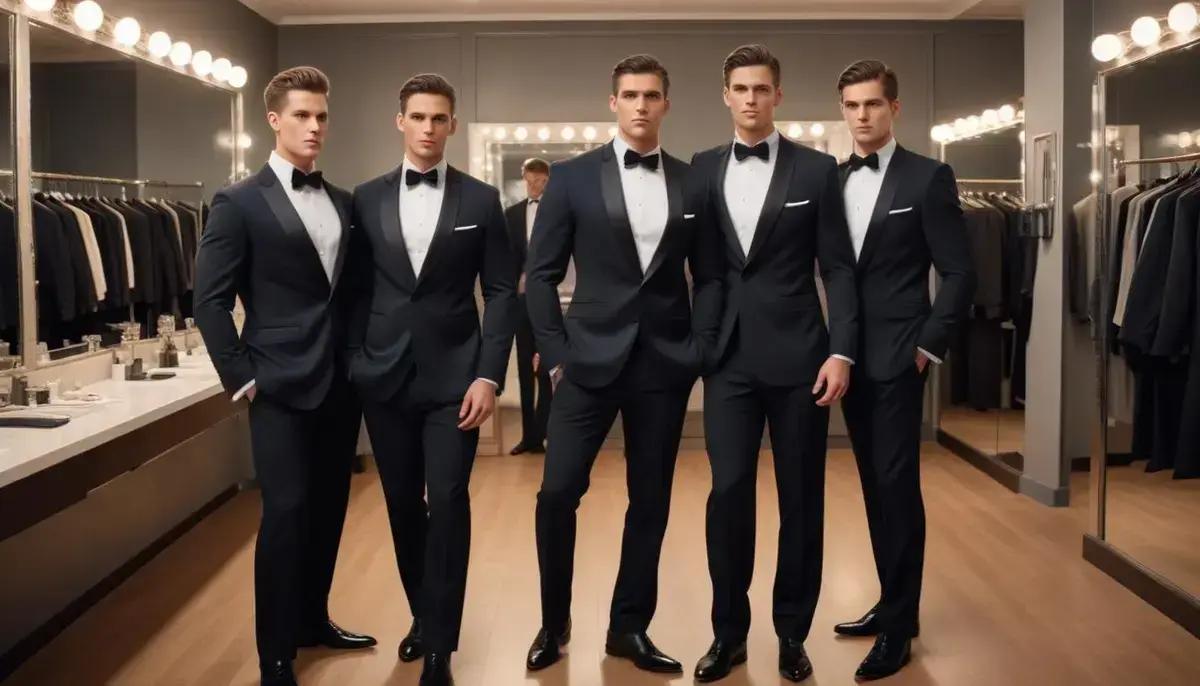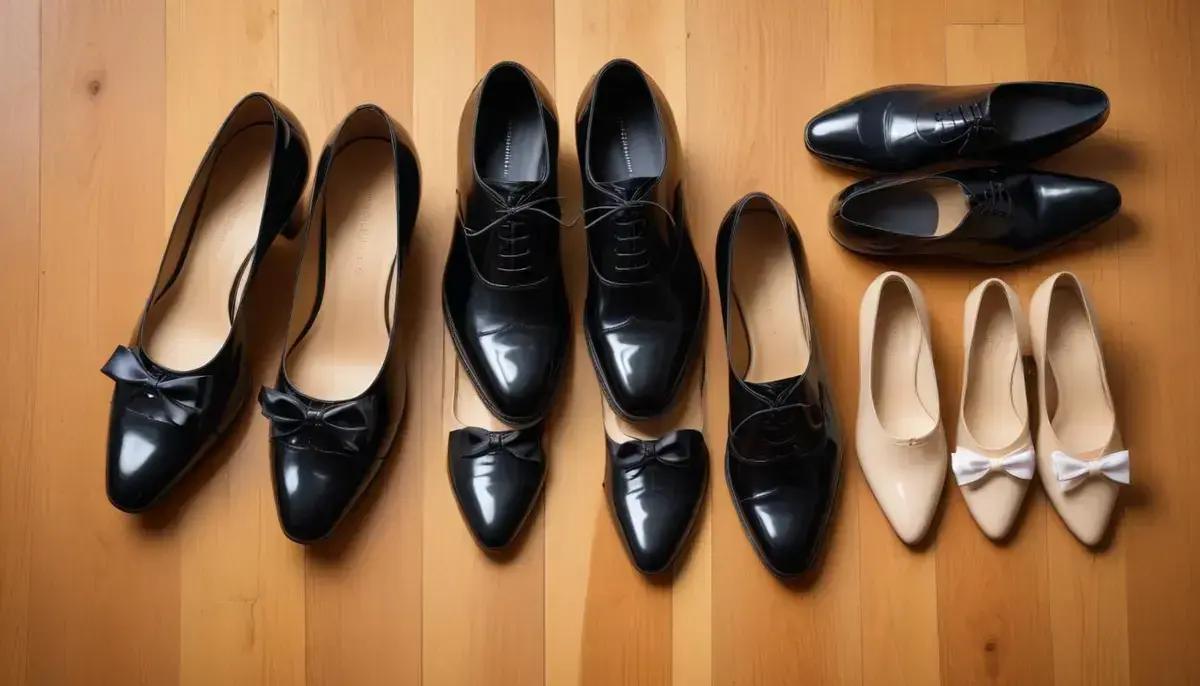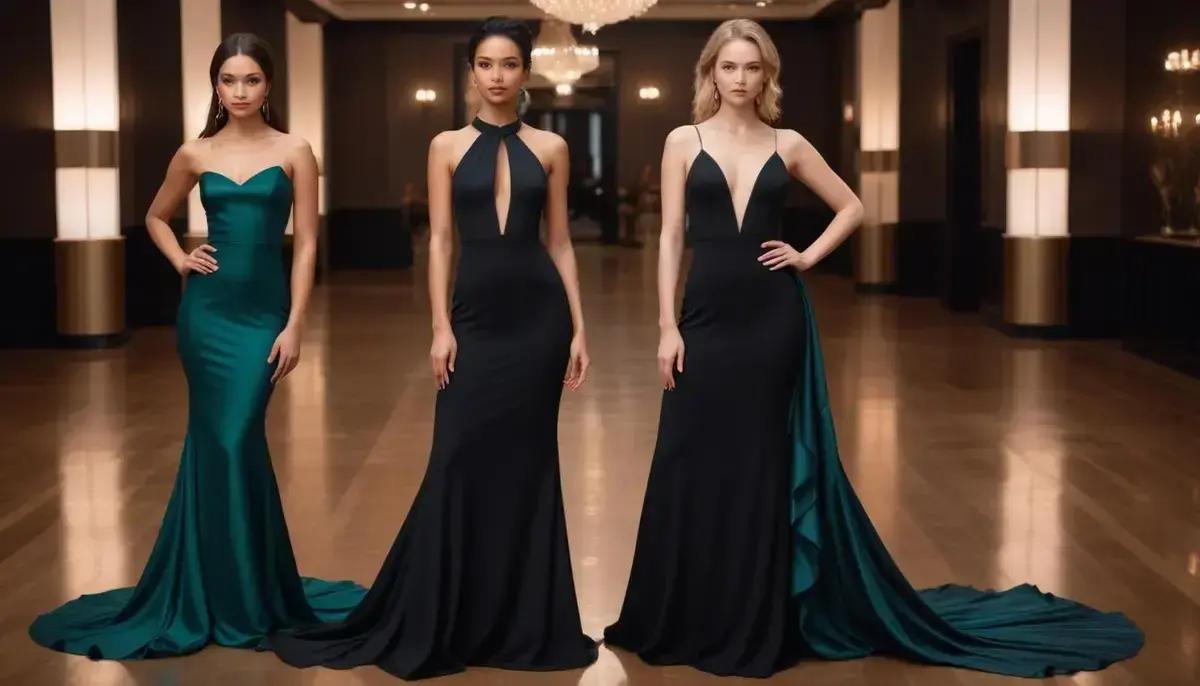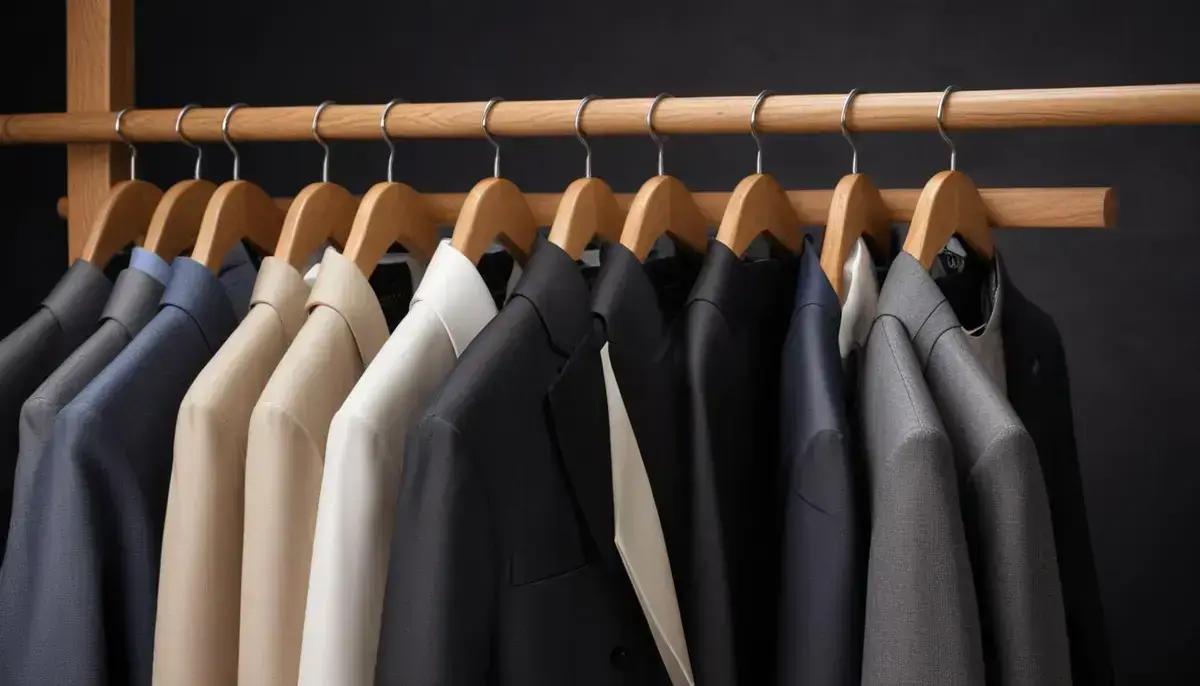Black tie represents the pinnacle of masculine elegance at formal events, but its rules can confuse even the most experienced. Mastering this dress code isn’t just about wearing a tuxedo—it’s about understanding every detail that makes up classic sophistication.
What is the black tie dress code and when to wear it?
The black tie dress code represents formal evening attire, typically worn for events starting after 6 PM. It sits between business formal and white tie in terms of formality, making it perfect for weddings, galas, and upscale dinners. Unlike casual wear, every element follows strict traditions that have evolved over a century.
Key Characteristics of Black Tie
Traditional black tie consists of a black dinner jacket with satin or grosgrain lapels, matching trousers with a satin stripe, and a crisp white dress shirt. The outfit is completed with a black bow tie, cummerbund or waistcoat, and polished patent leather shoes. This ensemble creates a timeless, sophisticated look.
When to Wear Black Tie
Black tie is appropriate for formal evening events such as opera openings, charity balls, and upscale weddings. Many private dinners and corporate events with ‘black tie optional’ designations also welcome this attire. However, it’s generally not worn for daytime occasions unless specified otherwise.
Modern interpretations allow for subtle variations like midnight blue jackets or patterned bow ties, but the core elements remain unchanged. Understanding these rules helps you dress appropriately while expressing personal style within classic boundaries.
The difference between a tuxedo and a tailcoat in formal protocol

While both tuxedos (smoking) and tailcoats (fraque) belong to formal wear, they serve different purposes in dress code hierarchy. The tuxedo, with its shorter jacket and satin details, is designated for black tie events, while the tailcoat’s distinctive cutaway front and longer tails mark it as white tie attire – the most formal eveningwear.
Key Structural Differences
A tuxedo jacket features satin or grosgrain lapels and buttons, with a straight hem that covers the hips. The tailcoat, by contrast, has a sharply cutaway front exposing the waistcoat, with long tails extending to knee-length at the back. This dramatic silhouette dates back to 19th century equestrian uniforms adapted for evening wear.
When Each Is Worn
The tuxedo suits modern formal occasions like weddings and galas, while the tailcoat remains reserved for ultra-formal events: diplomatic receptions, royal balls, and some classical music performances. Interestingly, while tuxedos use bow ties, tailcoats traditionally pair with white piqué bow ties and high-waisted trousers.
Fabric choices also differ significantly – tuxedos often use lightweight wools for comfort, while tailcoats maintain rigid structure with heavier materials. Understanding these distinctions ensures you’ll never confuse these two pillars of formal menswear.
Essential Components of Men’s Black Tie Attire
A proper black tie ensemble consists of several key components that work together to create a polished, elegant look. The foundation is a black dinner jacket with satin or grosgrain lapels, typically made from high-quality wool or a wool-silk blend. This should be paired with matching trousers featuring a single satin braid down each leg.
The Shirt and Neckwear
The white dress shirt must have a marcella (piqué) or pleated front, with either a turndown or wing collar. A black bow tie, preferably self-tied and made from silk or satin, completes the neckwear. Avoid pre-tied bows as they appear less sophisticated.
Essential Accessories
No black tie outfit is complete without a cummerbund (worn with pleats facing up) or a low-cut waistcoat. Other crucial elements include:
- Patent leather or highly polished black oxford shoes
- Black silk dress socks
- Minimalist cufflinks and studs
- White linen pocket square
Remember that each component follows strict traditional guidelines – deviations like colored shirts or long ties immediately downgrade the formality. The magic of black tie lies in its precise combination of these elements.
How to Choose the Perfect Tuxedo for Your Body Type

Choosing the perfect tuxedo for your body type requires understanding how different cuts and details can enhance your silhouette. The key is balancing proportions while maintaining the formal integrity of black tie attire.
For Slim Body Types
Opt for a slim-fit jacket with narrower lapels to complement your frame. A single-button closure creates a longer vertical line. Consider trousers with a slightly higher waist and minimal break at the shoes to add visual length.
For Athletic Builds
Look for jackets with structured shoulders and a tapered waist to highlight your V-shape. Peak lapels can broaden the shoulders further. Avoid overly tight fits that restrict movement – proper tailoring is crucial for comfort.
For Larger Frames
Choose a classic fit jacket with wider lapels to balance proportions. A two-button style helps minimize the midsection. Dark fabrics with minimal sheen are most flattering. Straight-leg trousers with a clean drape work best.
Regardless of body type, always prioritize proper tailoring. The right tuxedo should skim your body without pulling or bagging. Remember: fit trumps fashion in formalwear – a well-proportioned silhouette always looks more elegant than trendy cuts.
Mandatory accessories: bow tie, cummerbund, and cufflinks
The right accessories elevate a black tie ensemble from good to exceptional. Three elements are non-negotiable: the bow tie, cummerbund, and stud set, each serving both aesthetic and functional purposes in formalwear.
The Bow Tie
A self-tie black bow tie in silk or satin is the only acceptable neckwear for black tie. The width should match your lapels (typically 2.5-3 inches). Pre-tied versions lack the charming imperfection of a hand-tied bow, which signals sartorial sophistication.
The Cummerbund
This pleated waist covering originated as a substitute for waistcoats. Wear it with the pleats facing upward (traditionally to catch theater ticket stubs) and positioned to cover the shirt’s waistband. Black is standard, but midnight blue offers subtle variation.
Stud Set and Cufflinks
Formal shirts require shirt studs instead of buttons. Opt for simple onyx or mother-of-pearl sets. Matching cufflinks should be understated – avoid novelty designs. These metallic accents should coordinate with other jewelry like watches.
Together, these accessories create visual harmony. They bridge the gap between jacket and trousers while maintaining the monochromatic elegance that defines black tie dress code.
Appropriate Footwear for the Black Tie Dress Code

Footwear completes the black tie ensemble and requires as much attention as the suit itself. The only acceptable options are patent leather oxfords or opera pumps, both designed specifically for formal evening wear.
Patent Leather Oxfords
The most common choice, these high-gloss shoes feature a plain toe cap or wholecut design. Their mirror-like shine reflects light elegantly on dance floors. Ensure they’re properly broken in – nothing ruins an evening faster than blisters from stiff formal shoes.
Opera Pumps
For ultra-traditionalists, opera pumps with their distinctive grosgrain bows offer historical authenticity. These laceless slippers originated in 19th century court dress. Though less common today, they remain the most formal option for white tie events.
Avoid at All Costs
Never wear:
- Matte leather shoes
- Square-toed designs
- Loafers of any kind
- Dress boots
The shoes should have thin soles and minimal detailing to maintain sleek sophistication. Pair with black silk dress socks that cover the calf completely when seated.
Remember: your shoes should complement the outfit, not compete with it. A perfect black tie look flows seamlessly from head to toe.
Etiquette Rules for Black Tie Events
Attending a black tie event requires understanding both the dress code and accompanying etiquette. These unwritten rules ensure you respect the occasion’s formality while feeling confident in your ensemble.
Arrival and Greetings
The jacket must remain buttoned when standing, only unbuttoned when seated. Greet hosts with a firm handshake and maintain polished posture throughout the event. Remember – your tuxedo should command respect, not restrict movement.
Dining Protocol
Formal dinners demand particular attention:
- Napkin on lap immediately when seated
- Utensils used from the outside in
- No elbows on the table
- Discreet use of mobile devices
The cummerbund’s original purpose was to protect the shirt from spills – let it serve its function.
Dance Floor Decorum
When dancing, keep movements refined. The tuxedo’s construction allows for elegant motion – take advantage of this. Should your bow tie come undone, excuse yourself to retie it properly rather than leaving it dangling.
These guidelines aren’t about stiffness, but about honoring the tradition behind black tie occasions. Master them and you’ll move through any formal event with grace.
Women’s Black Tie: Elegance and Sophistication in Dresses

Women’s black tie attire offers more flexibility while maintaining the same level of sophistication as men’s formalwear. The foundation is an elegant evening gown that falls below the knee, though modern interpretations allow for chic jumpsuits and tailored suits.
Classic Evening Gowns
Traditional options include:
- Floor-length column dresses in luxe fabrics
- Ballgowns with structured bodices
- Mermaid or trumpet silhouettes
Dark hues like black, navy, or deep jewel tones remain most formal, while metallic accents add glamour.
Contemporary Alternatives
Modern black tie permits:
- High-quality evening jumpsuits with wide-leg pants
- Tailored tuxedo-inspired suits
- Cocktail-length dresses for certain events
The key is maintaining formal fabric choices – silk, satin, velvet, or high-end lace.
Accessories and Details
Complete the look with:
- Clutch purses instead of daytime handbags
- Elegant heels or formal flats
- Minimalist jewelry that complements rather than overwhelms
Remember – in black tie, restraint often reads as the ultimate sophistication.
Common Mistakes that Compromise the Black Tie Look
Avoiding common black tie mistakes is crucial to maintaining the elegance this dress code demands. Even small errors can undermine an otherwise perfect formal look.
Faux Pas in Attire
The most frequent missteps include:
- Wearing a long necktie instead of a bow tie
- Choosing a colored dress shirt instead of white
- Opting for matte shoes rather than patent leather
- Using a belt instead of suspenders or a cummerbund
Fit and Fabric Issues
Poor tailoring ruins the effect:
- Jacket sleeves that are too long or short
- Trousers that pool around the ankles
- Overly tight or baggy fits
- Cheap-looking synthetic fabrics that don’t drape well
Accessory Missteps
Common accessory errors:
- Wearing a wristwatch with formalwear
- Choosing novelty cufflinks or loud patterns
- Carrying a daytime briefcase instead of a slim portfolio
- Visible undershirts or improper undergarments
Remember: black tie is about subtlety – anything that draws too much attention breaks the magic.
Brands and Where to Find Quality Tuxedos

Investing in a quality tuxedo means choosing reputable brands that specialize in formalwear. These manufacturers understand the precise tailoring and premium materials required for authentic black tie elegance.
Heritage Brands
For traditional craftsmanship:
- Brioni – Italian luxury with impeccable fit
- Tom Ford – Modern glamour with sharp silhouettes
- Ralph Lauren Purple Label – Classic American sophistication
Contemporary Options
Excellent modern choices include:
- Hugo Boss – Reliable quality at mid-range prices
- Suitsupply – Excellent value with half-canvas construction
- Reiss – Fashion-forward cuts with formal integrity
Where to Shop
Find quality tuxedos at:
- Specialty menswear boutiques for personalized service
- Department stores like Nordstrom or Saks Fifth Avenue
- Online made-to-measure services for perfect fit
- Rental shops for occasional wear (but invest if you attend 2+ events yearly)
Remember: a well-chosen tuxedo should last decades with proper care.
Modern Adaptations of Black Tie for Different Occasions
While traditional black tie follows strict rules, modern adaptations allow for flexibility across different occasions without sacrificing elegance. These contemporary interpretations maintain the essence of formalwear while accommodating personal style and event requirements.
Creative Black Tie
For less formal events, creative black tie permits:
- Dark suits instead of tuxedos
- Colored bow ties or cummerbunds
- Patterned dress shirts
- Velvet or textured jackets
This works well for holiday parties or artistic events.
Seasonal Variations
Adapt your tuxedo for different seasons:
- Summer: Lighter fabrics like tropical wool
- Winter: Velvet accents or deeper colors
- Spring/Fall: Mid-weight materials with seasonal accessories
Location-Based Adjustments
Consider the venue:
- Beach weddings: Linen blend jackets
- Urban events: Slimmer silhouettes
- Destination events: Wrinkle-resistant fabrics
The key is maintaining sophistication while adapting to context.
These modern interpretations prove black tie can evolve while retaining its core identity as the pinnacle of evening elegance.
Mastering the Art of Black Tie
Understanding black tie etiquette is about more than just wearing the right clothes – it’s about embracing a tradition of elegance that has stood the test of time. From selecting the perfect tuxedo to mastering formal accessories and modern adaptations, each element contributes to creating an impeccable evening look.
Remember that true sophistication comes from confidence in your choices. Whether attending a gala, wedding, or formal dinner, your knowledge of black tie rules allows you to navigate any event with poise. The guidelines we’ve explored serve as your foundation, but personal style and comfort should always shine through.
As fashion evolves, so do interpretations of formalwear, but the core principles of black tie remain timeless. Keep these lessons in mind, and you’ll always make the right impression when dressing for life’s most elegant occasions.







